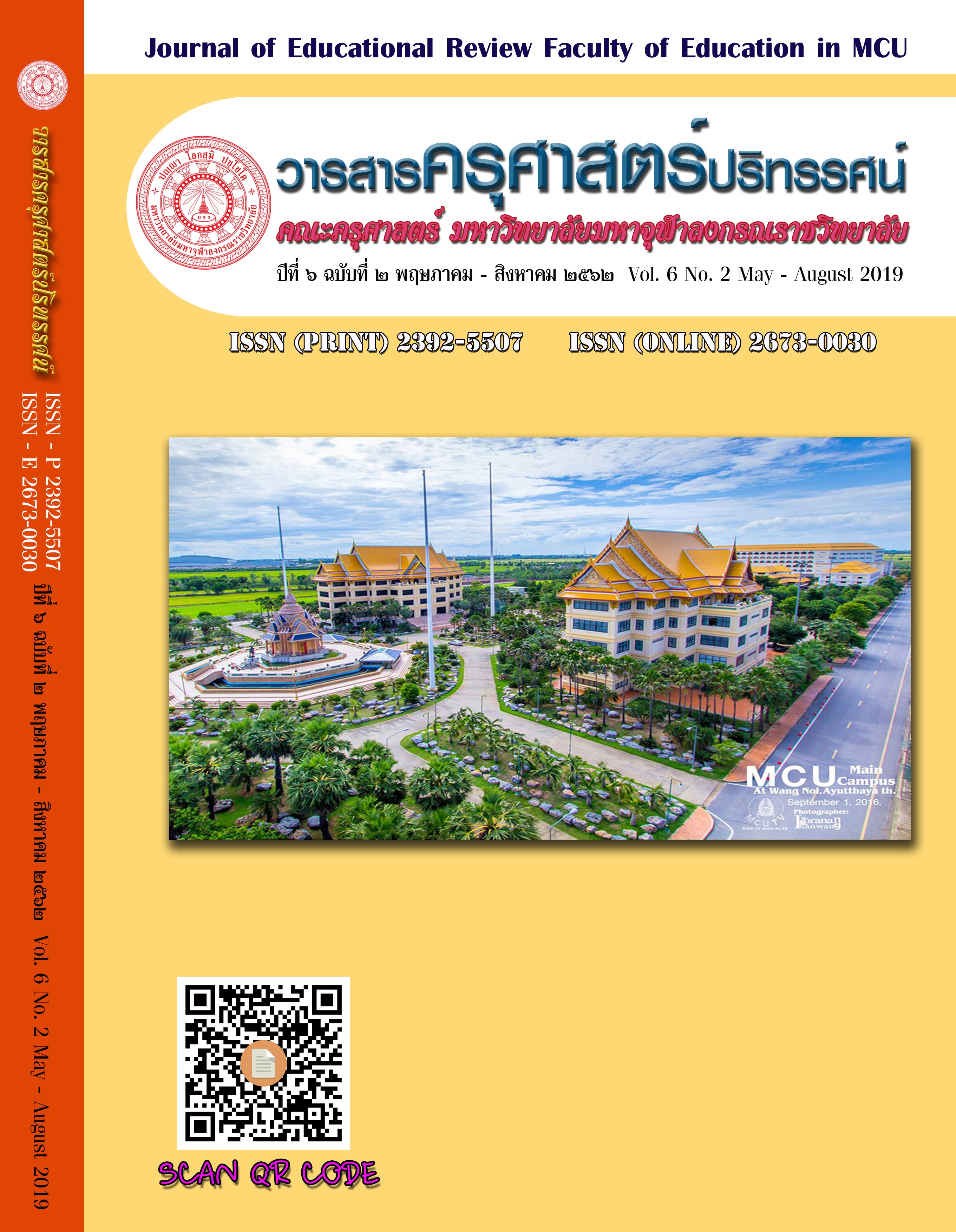การพัฒนาอีเลิร์นนิงคอร์สแวร์ด้วยการถอดบทเรียนหลังปฏิบัติการของนักเรียนชั้นมัธยมศึกษาปีที่ ๒
Main Article Content
บทคัดย่อ
การวิจัยครั้งนี้มีวัตถุประสงค์เพื่อ ๑) พัฒนาอีเลิร์นนิงคอร์สแวร์ด้วยการถอดบทเรียนหลังปฏิบัติการของนักเรียนชั้นมัธยมศึกษาปีที่ ๒ ๒) เปรียบเทียบผลสัมฤทธิ์ทางการเรียนของนักเรียนชั้นมัธยมศึกษาปีที่ ๒ ก่อนเรียนกับหลังเรียนด้วยอีเลิร์นนิงคอร์สแวร์ด้วยการถอดบทเรียนหลังปฏิบัติการ ๓) ศึกษาวิธีปฏิบัติที่ส่งผลต่อความสำเร็จในการทำผลงานสร้างสรรค์ของนักเรียนชั้นมัธยมศึกษาปีที่ ๒ ที่เรียนด้วยอีเลิร์นนิงคอร์สแวร์ด้วยการถอดบทเรียนหลังปฏิบัติการ ๔) เปรียบเทียบคะแนนผลงานสร้างสรรค์ก่อนเรียนกับหลังเรียนของนักเรียนชั้นมัธยมศึกษาปีที่ ๒ ที่เรียนด้วยอีเลิร์นนิงคอร์สแวร์ด้วยการถอดบทเรียนหลังปฏิบัติการ ๕) เพื่อศึกษาความพึงพอใจของนักเรียนชั้นมัธยมศึกษาปีที่ ๒ ต่ออีเลิร์นนิงคอร์สแวร์ด้วยการถอดบทเรียนหลังปฏิบัติการ
กลุ่มตัวอย่างในการวิจัยครั้งนี้ คือ นักเรียนชั้นมัธยมศึกษาปีที่ ๒ โรงเรียนสระบุรีวิทยาคม จำนวน ๓๐ คน ได้มาโดยการโดยการสุ่มอย่างง่าย จาก ๖ ห้องเรียน โดยวิธีการจับสลาก เพื่อเข้ากลุ่มตัวอย่าง เครื่องมือที่ใช้ในการวิจัยได้แก่ ๑) อีเลิร์นนิงคอร์สแวร์ด้วยการถอดบทเรียนหลังปฏิบัติการของนักเรียนชั้นมัธยมศึกษาปีที่ ๒ ๒) แบบทดสอบวัดผลสัมฤทธิ์ทางการเรียน ๓) แบบประเมินผลงานสร้างสรรค์ ๔) แบบสอบถามความพึงพอใจ สถิติที่ใช้วิเคราะห์ข้อมูลได้แก่ ค่าเฉลี่ย ค่าเบี่ยงเบนมาตรฐาน และการทดสอบค่า t-test แบบ dependent
ผลการวิจัยพบว่า ๑) อีเลิร์นนิงคอร์สแวร์ด้วยการถอดบทเรียนหลังปฏิบัติการ มีประสิทธิภาพ (E๑/E๒) เท่ากับ ๘๘.๗๒ /๘๗.๑๗ ๒) ผู้เรียนมีผลสัมฤทธิ์ทางการเรียนเฉลี่ยหลังเรียนสูงกว่าก่อนเรียนอย่างมีนัยสำคัญทางสถิติที่ระดับ .๐๕ ๓) วิธีปฏิบัติที่ส่งผลต่อความสำเร็จของการทำผลงานสร้างสรรค์ ดังนี้ ศึกษาบทเรียนให้มีความรู้ความเข้าใจในการใช้โปรแกรมอย่างชัดเจน การฝึกฝนเพื่อให้ทราบวิธีการทำงานหรือข้อจำกัด ทำให้ทำงานได้อย่างคล่องแคล่ว สนับสนุนคอมพิวเตอร์ ระบบอินเทอร์เน็ต เพื่อสะดวกในการเรียนรู้ ๔) นักเรียนมีผลงานสร้างสรรค์ด้วยหลังเรียนสูงกว่าก่อนเรียน อย่างมีนัยสำคัญทางสถิติที่ระดับ .๐๕ ๕) ผู้เรียนมีความพึงพอใจต่อบทเรียนอีเลิร์นนิงคอร์สแวร์ด้วยการถอดบทเรียนหลังปฏิบัติการอยู่ในระดับมาก
Article Details
ทัศนะและความคิดเห็นที่ปรากฏในบทความในวารสารฉบับนี้ถือเป็นความรับผิดชอบของผู้เขียนบทความนั้นเพียงผู้เดียว และไม่ถือเป็นทัศนะและความรับผิดชอบของกองบรรณาธิการ
กองบรรณาธิการขอสงวนสิทธิ์ในการคัดเลือกบทความลงตีพิมพ์และจะแจ้งให้เจ้าของบทความทราบหลังจากผู้ประเมินบทความตรวจอ่านบทความแล้ว
ต้นฉบับที่ได้รับการตีพิมพ์ในวารสารครุศาสตร์ปริทรรศน์ คณะครุศาสตร์ มหาวิทยาลัยมหาจุฬาลงกรณราชวิทยาลัย ถือเป็นกรรมสิทธิ์ของคณะครุศาสตร์ มหาวิทยาลัยมหาจุฬาลงกรณราชวิทยาลัย ห้ามนำข้อความทั้งหมดหรือบางส่วนไปพิมพ์ซ้ำ เว้นเสียแต่ว่าจะได้รับอนุญาตจากมหาวิทยาลัยฯ เป็นลายลักษณ์อักษร
เอกสารอ้างอิง
กระทรวงศึกษาธิการ. (๒๕๕๑). หลักสูตรแกนกลางการศึกษาขั้นพื้นฐานพุทธศักราช ๒๕๕๑. กรุงเทพมหานคร:โรงพิมพ์ชุมนุมสหกรณ์การเกษตรแห่งประเทศไทย.
กิดานันท์ มลิทอง. (๒๕๔๘). เทคโนโลยีและการสื่อสารเพื่อการศึกษา. กรุงเทพมหานคร : โรงพิมพ์อรุณการพิมพ์.
จินตวีร์ คล้ายสังข์. (๒๕๕๕). E-Learning Courseware อีเลิร์นนิงคอร์สแวร์ :แนวคิดสู่การปฏิบัติสำหรับการเรียนการสอนอีเลิร์นนิงในทุกระดับ. กรุงเทพมหานคร : สำนักพิมพ์แห่งจุฬาลงกรณ์มหาวิทยาลัย.
ชัยยงค์ พรหมวงศ์. (๒๕๔๓). การคำนวณหาประสิทธิภาพของแบบฝึกทักษะ. กรุงเทพมหานคร: ไทยวัฒนาพานิช.
ฐิติยา อินตะนา. (๒๕๕๘). การพัฒนาบทเรียนอิเล็กทรอนิกส์เรื่องพลเมืองดีตามวิถีประชาธิปไตยสำหรับนักเรียนชั้นประถมศึกษาปีที่ ๖. วิทยานิพนธ์ปริญญาครุศาสตร
มหาบัณฑิต. บัณฑิตวิทยาลัย : มหาวิทยาลัยเกษตรศาสตร์
ถนอมพร เลาหจรัสแสง. (๒๕๔๔). การสอนบนเว็บ (Web-Based Instruction) นวัตกรรมเพื่อคุณภาพการเรียนการสอน. วารสารศึกษาศาสตร์สาร. ๒๘(๑). ๘๗-๙๔.
ถนอมพร เลาหจรัสแสง. (๒๕๔๕). Designing e-Learning : หลักการออกและการสร้างเว็บเพื่อการเรียนการสอน. กรุงเทพมหานคร: อรุณการพิมพ์.
บุญเหลือ ทองอยู่. (๒๕๒๑). ความคิดสร้างสรรค์. มิตรครู. ๗(๔) :๓-๔.
ประภาพรรณ อุ่นอบ. (๒๕๕๗). (๑ มี.ค. ๒๕๖๒). แนวคิดและวิธีวิทยาการถอดบทเรียน. คณะสังคมศาสตร์และมนุษย์ศาสตร์ มหาวิทยาลัยมหิดล. แหล่งที่มา: https://bsris.swu.ac.th/health/doc/280254.pdf
ล้วน สายยศ และอังคณา สายยศ. (๒๕๔๓). สถิติทางการวิจัย. พิมพ์ครั้งที่ ๓. กรุงเทพมหานคร: สุวีริยาสาส์น.
วรางคณา จันทร์คง (๒๕๕๗). (๑ มี.ค. ๒๕๖๒). การถอดบทเรียน.จุลสารสาขาวิชาวิทยาศาสตร์สุขภาพ. แหล่งที่มา: https://www.stou.ac.th/Schools/Shs/booklet/book๕๗๒/rsearch572.pdf
ศิริชัย นามบุรี. (๒๕๕๐). การเปรียบเทียบผลสัมฤทธิ์ทางการเรียนและความพึงพอใจของผู้เรียนโดย ใช้กิจกรรมหนังสืออิเล็กทรอนิกส์และบทเรียนสําเร็จรูปอิเล็กทรอนิกส์ในสภาพแวดล้อมแบบอีเลิร์นนิ่งผ่านโปรแกรม Moodle. วิทยานิพนธ์าครุศาสตรมหาบัณฑิต. บัณฑิตวิทยาลัย: มหาวิทยาลัยราชภัฏยะลา.
สาวิตรี เล็กสวัสดิ์. (๒๕๕๔). การพัฒนาบทเรียนอิเล็กทรอนิกส์บนเครือข่าย เรื่องวัฒนธรรมองค์การ. วิทยานิพนธ์ปริญญาครุศาสตรมหาบัณฑิต. บัณฑิตวิทยาลัย : มหาวิทยาลัยเชียงใหม่.
เอกรินทร์ วิจิตต์พันธ์. (๒๕๔๖). การพัฒนา e-Learning วิชาการสื่อสารข้อมูล สำหรับนักศึกษาระดับประกาศนียบัตรวิชาชีพชั้นสูง สาขาวิชาเทคนิคคอมพิวเตอร์ สถาบันเทคโนโลยีราชมงคล. วิทยานิพนธ์ปริญญาครุศาสตรมหาบัณฑิต. กรุงเทพมหานคร : สถาบันเทคโนโลยีพระจอมเกล้าพระนครเหนือ.
Davies, I.K. (1971). The Management of Learning. London: McGraw - Hill.


